





the staff
editor-in-chief holly funk editor@carillonregina.com
executive director vacant business@carillonregina.com
production manager shae sackman production@carillonregina.com
communications amin malakootikhah comms@carillonregina.com
web + advertising manager jaedyn whittal web@carillonregina.com
graphics editor lee lim graphics@carillonregina.com
copy editor emilie wren copyeditor@carillonregina.com
news editor allister white news@carillonregina.com
a&c editor mikayla tallon arts@carillonregina.com
s&h editor kimberley kaufman sports@carillonregina.com
op-ed editor hammad ali op-ed@carillonregina.com
distribution manager amin malakootikhah distribution@carillonregina.com
staff writer victoria baht
staff writer nazeemah noorally
staff writer maren savarese knopf
news writer shivangi sharma
a&c writer will bright s&h writer pall agarwal
contributors william bessai-saul, zinnia jaswal, alissa sadler
board of directors holly funk, tayef ahmed, muhammad zuhruf muhammad zarooq, mohammad akib hossain, and mikayla tallon
the paper
227 Riddell Centre @ the University of Regina 3737 Wascana Parkway, Regina, SK, Canada S4S 0A2 www.carillonregina.com | (306) 586 8867
Printed by Star Press Inc, Wainwright, AB
The Carillon welcomes contributions.
Opinions expressed in the pages of the Carillon are entirely those of the author, and do not necessarily reflect those of The Carillon Newspaper Inc. Opinions expressed in advertisements appearing in the Carillon are those of the advertisers, and not necessarily of The Carillon Newspaper Inc. or its staff.
The Carillon is published no less than 11 times each semester during the fall and winter semesters and periodically throughout the summer. The Carillon is published by the Carillon Newspaper Inc., a non-profit organization.
land acknowledgement
The Carillon is written on Treaty 4 territory. As such, staff recognize that we are living, working, and telling stories on and of Indigenous lands. We recognize that we are on the traditional homelands of the Cree, Saulteaux, Nakota, Lakota, and Dakota peoples, along with the homeland of the Métis nation. The Carillon understands that it is pointless to acknowledge the land on which we work without demonstrating our commitment to telling stories and prioritizing voices that further the return of this land to its sacred place. the manifesto
In keeping with our reckless, devil-may-care image, our office has absolutely no concrete information on the Carillon’s formative years readily available. What follows is the story that’s been passed down from editor to editor for over sixty years.
In the late 1950s, the University of Regina planned the construction of several new buildings on the campus grounds. One of these proposed buildlings was a belltower on the academic green. If you look out on the academic green today, the first thing you’ll notice is that it has absolutely nothing resembling a belltower.
The University never got a belltower, but what it did get was the Carillon, a newspaper that serves as a symbolic bell tower on campus, a loud and clear voice belonging to each and every student. the people’s friend; the tyrant’s foe






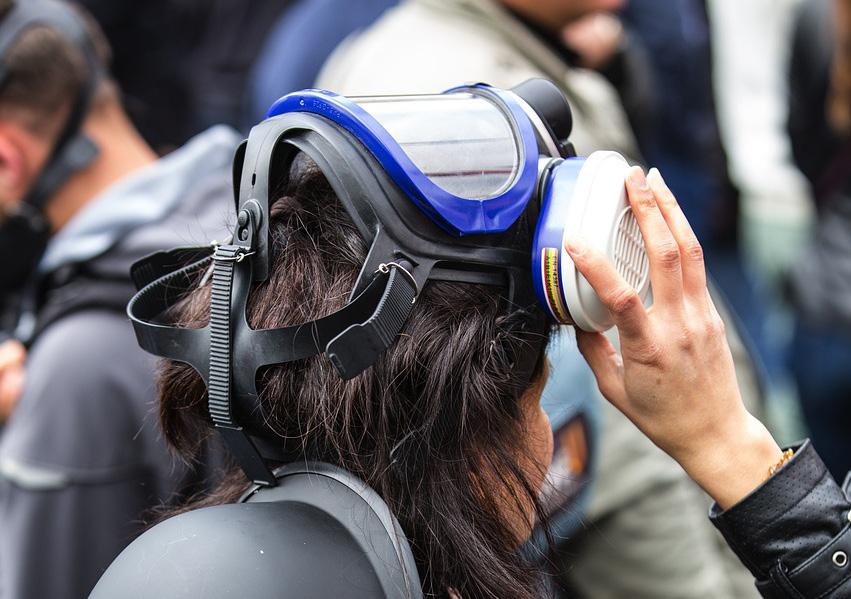
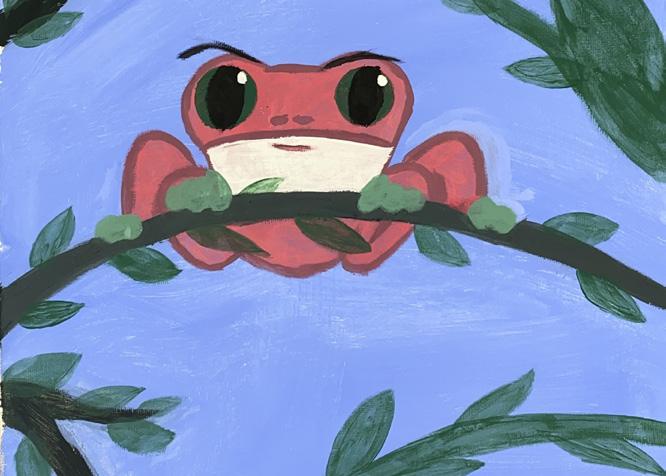

As far as this
Illegitimi non carborundum
holly funk editor-in-chief
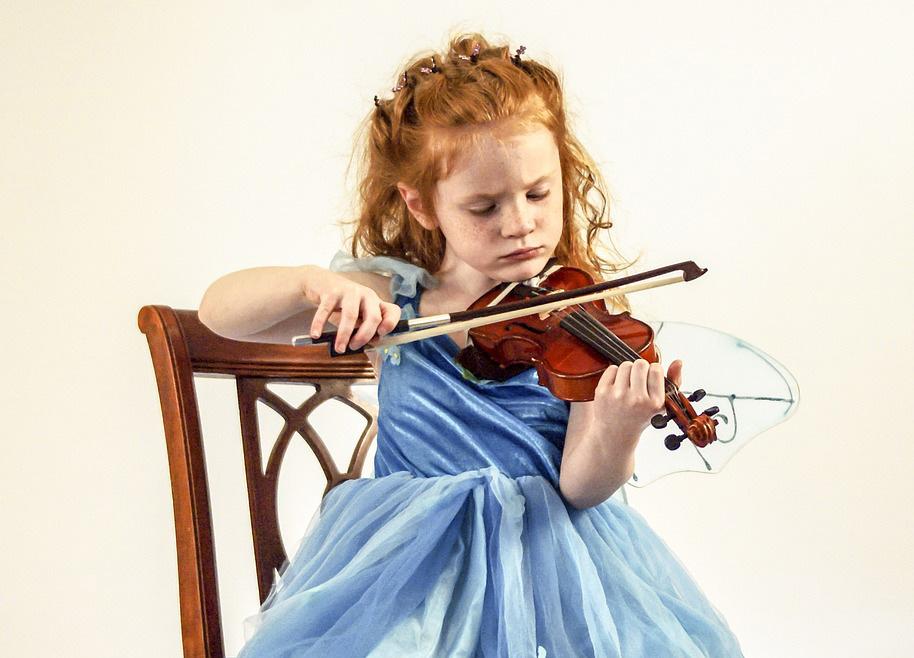




“Undervalued” provincial arts sector
The arts have positive impacts but, without funding, capacity for good is greatly reduced
staff writer
On Wednesday, March 20, Saskatchewan finance minister Donna Harpauer released the final provincial budget which projects a $273.2 million dollar deficit for the fiscal year.
Harpauer announced she would not be seeking re-election and had the following to say about the budget: “I would have loved to have ended [with a] budget that was balanced and was able to do a tax reduction. However, it is the budget I am comfortable with.”
According to Harpauer, colleagues of hers as well as the premier, Scott Moe, wanted to prioritize fiscal increases which she described as “the right thing to do right now.”
Saskatchewan’s 2024-2025 provincial budget is titled “Classrooms, Care & Communities.” The document reports record investments in education, health care, and community programs. The minister’s message details how “the 2024-25 Budget makes record investments in the provincial education system, record investments in health care and record investments in municipal revenue sharing to respond to the growing needs of Saskatchewan residents, families and communities.”
Harpauer also claims that “the 2024-25 Provincial Budget makes these important investments without introducing any new taxes or increasing existing ones. That’s just one feature of this year’s budget to make life more affordable for residents of the province.”
Among the “record increases,” arts funding remained minimal. Community Sport, Culture and recreation programs received $3.1 million. Heritage Institutions
received $17.31 million and the Saskatchewan Heritage Foundation $308,000.
A letter from the Saskatchewan Arts Alliance (SAA) in response to the 2024-25 budget states that “with the arts in Saskatchewan still being negatively affected by the ongoing impacts of the pandemic, massive inflation and the continued collection
culture in Saskatchewan during 2021 was over $922 million.
“Considering the estimated economic output of SK Arts’ funded organizations alone contributes approximately $74 million in economic output to the province, the overall contribution of arts & culture should not be undervalued,” writes the SAA.
Moreover, the SAA calls for
to stay in or move to communities that embrace the arts and the arts create stimulation, celebration, and hope. They promote a sense of community identity and express a Canadian identity at home and abroad.”
The arts also create employment for approximately 740,000 people across Canada, generate tax revenue, and increase con-
increased by 6 per cent; however, these increases were negatively impacted by the pandemic.
The arts and culture sector recovered well in 2021 and significantly contributed to the provincial GDP. Statistics Canada demonstrates that between 2021 and 2022 Saskatchewan continued to have a positive increase –one that measured approximately
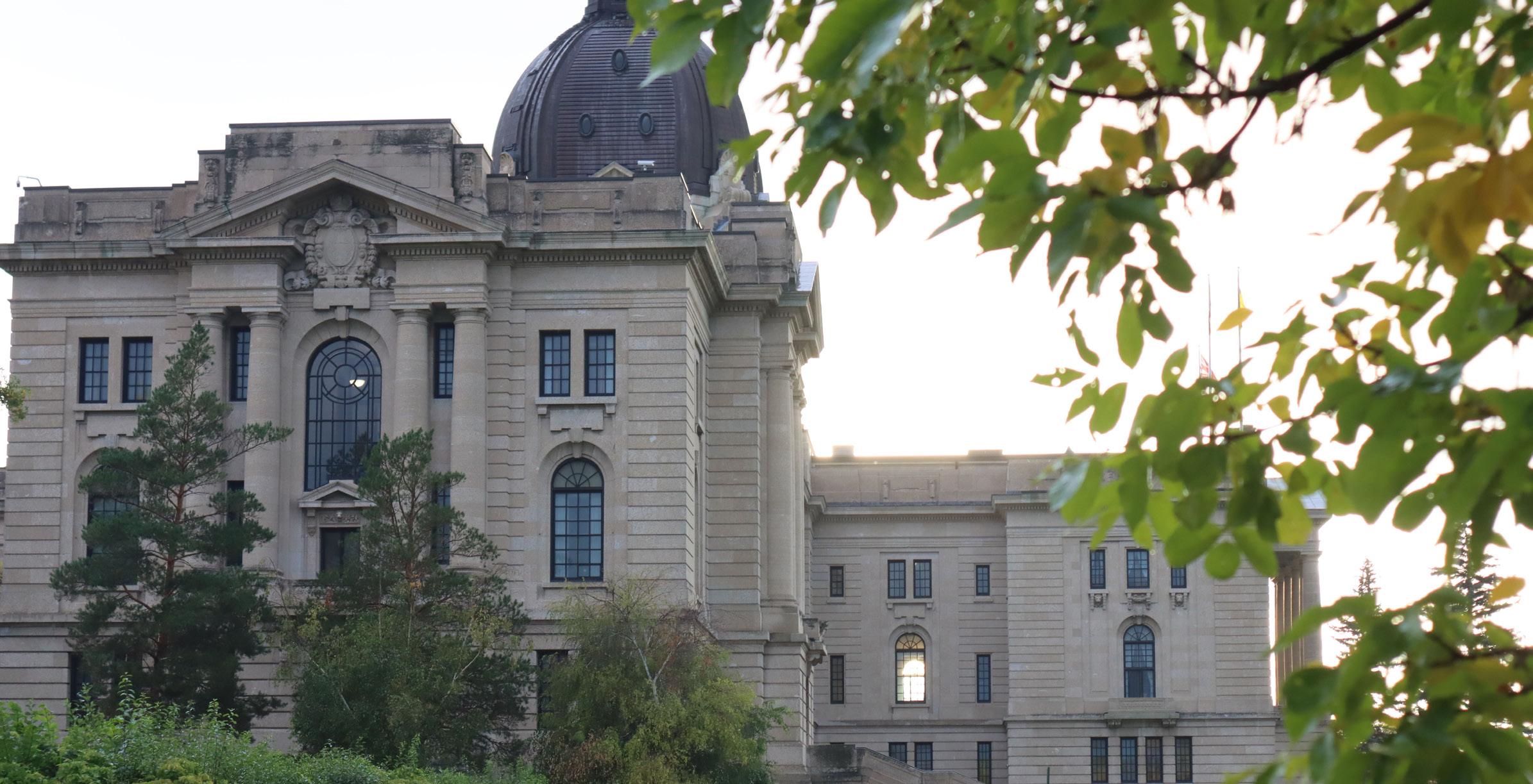

of the PST expansion on admissions, entertainment and recreation, [they are] disappointed with yet another year of status quo funding to the provincial arts sector.”
According to the SAA, the provincial budget as “a status quo budget for a sector in crisis is, simply, not good enough. Funding to SK Arts is flatlined and well below historical levels – approximately $383,000 less than a decade ago.”
The letter reminds the provincial government that Saskatch-
the government to recognize that arts and cultural programs are essential to the quality of life for those living within Saskatchewan.
This is a stance that has been incorporated into government elsewhere and reflected in budgeting. The Ontario Arts Council states that “the arts are essential to the quality of life, cultural identity, social well-being and economic prosperity of Ontario and access to the arts enhances lives, fosters creativity and innovation and strengthens communities.”
According to the SAA, there
sumer spending.
Furthermore, previous Canadian research has demonstrated how arts and culture sectors contribute to provincial GDP. From 2010-2020 GDP growth was 4 per cent in B.C. and 3 per cent in Nunavut, after adjusting for inflation and population growth.
“ a status quo budget for a sector in crisis is, simply, not good enough. Funding to SK Arts is flatlined and well below historical levels – approximately $383,000 less than a decade ago.”
Saskatchewan Arts Alliance
20.5 per cent. Still, this increase in GDP for arts and culture was among the lowest in Western Canada – Manitoba increased by 40 per cent, Alberta by 24.9 per cent, and BC by 28.3 per cent. Large increases demonstrate a strong arts and culture sector.
and the Saskatchewan Science Center received approximately $5.5 million. The Saskatchewan Arts Board received $6.75 million in funding while the Community Initiative Fund received $8.47 million. Creative Saskatchewan
ewan’s arts and culture sector positively contributes to the provincial economy and is therefore worthy of significant investment and concern. According to the SAA, the gross domestic product (GDP) generated by arts and
are multiple benefits to having the arts present in Saskatchewan communities. These include, “strengthened social bonds, creating common memories and a community in which people want to participate, encourage others
However, in Saskatchewan, the cultural economy decreased by 7 per cent between 2010 and 2019 and by the same percentage in 2020 for an overall decrease of 14 per cent between 2010 and 2020.
Decreases could be attributed to a number of factors, including lack of prioritized funding and support for the arts and culture sector. Prior to the pandemic, the number of arts and culture jobs
Prior to the release of the Saskatchewan 2024-2025 provincial budget the SAA was concerned with proposed cuts in the Canadian Heritage and Canada Council for the Arts.
In an open letter to Minister of Canadian Heritage, Pascale St-Onge; Minister of Finance, Chrystia Freeland; and president of the Treasury Board, Anita Anand, the SAA wrote that they were “deeply concerned about these proposed cuts and the impacts on our province’s arts and cultural organizations.”
“We understand and respect the need for fiscal restraint in a moment of high interest rates and an affordability crisis. However, we cannot express enough our profound dismay at the choice to cut from government departments, cuts that go beyond the sunsetting of emergency and recovery programs to the core work of Canadian Heritage and the Canada Council,” wrote the SAA.
The arts and culture sector in Saskatchewan is marked by the government’s “status quo” of budgeting with an uncertain future.
As of March 28, 2024, at least 95 journalists have been killed in less than six months
shivangi sharma news writer
Since the most recent escalation of armed conflict between Israel and Hamas-led militant groups on Oct 7, 2023, the world has watched violence so extreme it is near-unfathomable.
According to the Gazan health ministry, the death toll in Gaza now stands at 32,000 casualties – civilian and combatant combined.
According to a report published by Oxfam International on Jan 11, 2024, Israel’s military is responsible for killing Palestinians at an average rate of 250 people a day. This average death toll exceeds the daily death toll of any other major conflict of the 21st century, yet many major powers still have not called adamantly for a ceasefire. As a result, civilians continue to lose their lives without any foreseeable end.
Reports from the ground have been instrumental in exposing the reality of what is happening in Gaza. Hospitals are being bombed, leaving children to bleed to death, and surgeries are taking place without anesthesia.
A United Nations (UN) expert panel confirmed in February 2023 that allegations of Palestinian women and girls being subjected to sexual assault, rape, and threats of sexual violence while in Israeli detention “are credible.”
Evidence also exists that sexual violence took place against Israeli women and girls during the initial conflict on Oct 7. This marks the weaponization of gender-based sexual violence in an already violent conflict.
As a result, a wave of collective disgust has swept through the globe. Protests, walk-outs, and rallies have taken place across the world. Journalists have played an indispensable role in covering the realities at great personal risk.
Many journalist have lost their lives while reporting from the conflict zone. In a report published by the Committee to Protect Journalists (CPJ), as of March 28, 2024, 95 journalists and media
Multiple incidents of assaults, threats, cyberattacks, censorship, and killings of family members were also reported. CPJ also claimed that over 75 per cent of the journalists who were killed lost their lives in Gaza.
The Israel Defense Force (IDF) told Reuters and Agence France Press (APC) news agencies back in October that it could not guarantee the safety of their journalists operating in the Gaza Strip, after they had sought assurances that their journalists would not be targeted by Israeli strikes.
“The IDF is targeting all Hamas military activity throughout Gaza. […] Under these circumstances, we cannot guarantee your employees’ safety, and strongly urge you to take all necessary measures for their safety,” read a letter by the IDF letter to Reuters and APC. It should be noted that journalists are to be protected by international humanitarian law when covering armed conflicts.
CPJ’s report also had the names and lives of each and every individual journalist who has been reported dead or injured since October 2023. The story of every single journalist is a reminder that these were individuals with their own lives, dreams, and aspirations. Individuals whose dedication to their jobs and determination to report on and about the lives of those surviving in a wartorn region stripped them of their own lives.
“CPJ emphasizes that journalists are civilians doing important work during times of crisis and must not be targeted by warring parties,” said Sherif Mansour, CPJ’s Middle East and North Africa program coordinator. “Journalists across the region are making great sacrifices to cover this heartbreaking conflict. Those in Gaza, in particular, have paid, and continue to pay, an unprecedented toll and face exponential threats. Many have lost colleagues, families, and media facilities, and have fled seeking safety when there is no safe haven or exit.”
Unlike conflicts in other

airstrikes and restricted access to Gaza by the IDF have made it practically impossible for international journalists to enter the conflict zone. As a result, local journalists have been left to work alone.
“The lack of access for outside journalists means these jour-
“Every journalist killed is a further blow to our understanding of the world.”
Jodie Ginsberg
correspondent with Turkish Radio and Television who is currently based in Gaza, remembers getting a call from his brother in the middle of an assignment. His brother told Sadawi that their entire family had been told to evacuate and that an IDF air strike could hit at any moment.
“We’re not looking for appreciation or for words of encouragement,” Sadawi said. “We just need to be protected. We’re telling stories. It’s our job.”
Although the conflict between Israel and Gaza has been highlighted in the last six months, it is important to note that the crisis is not new in any sense. The region has been under conflict for nearly a century, and journalists and media personnel have continued to risk their lives to report on it.
Israeli forces. According to the Palestinian Journalists Syndicate (PJS), an estimated 50 Palestinian journalists were killed between 2000 and 2022.
Reporters Without Borders states that at least 144 journalists have been wounded by Israeli forces, including with bullets, batons, and stun grenades, since 2018.
Journalism requires courage. To bring the truth to light, be a voice for the masses, and be a check and balance to those in power is not only brave but selfless as well.
workers were confirmed dead. 90 were Palestinian, 2 were Israeli, and 3 were Lebanese. 16 journalists were reported injured, 4 were reported missing, and 25 journalists were reported arrested.
Middle Eastern countries like Syria, Afghanistan, and Iraq, which were covered by both local and international journalists, reports from Gaza come primarily through local journalists. Heavy
nalists are left with an outsized burden of coverage, […] so it’s really the Gazan journalists who are paying this price,” said American journalist Amat Khan.
Nizar Sadawi, a Palestinian
181 journalists were reported injured in 2018 while covering rallies in Gaza. A building housing international media offices – including the Associated Press and Al Jazeera – was targeted and destroyed by Israeli airstrikes in May 2021. The attack claimed the lives of several journalists.
Al Jazeera’s Shireen Abu Akleh was executed in 2022 by the
As a result, we “must work collectively to ensure that journalist killers are brought to justice […] and that the public’s right to be informed is protected from those whose power is threatened by the scrutiny of reporting,” said Jodie Ginsberg, CPJ’s chief executive officer. “Every journalist killed is a further blow to our understanding of the world.”
shivangi sharma news writer
In response to Bell Canada Enterprise Inc. (BCE Inc.) postposing a scheduled hearing in front of the House of Commons Heritage Committee to answer for the termination of 9 per cent of BCE’s employees, Unifor – a private sector union – rallied in Ottawa on March 19, 2024.
In February of 2024, BCE Inc. announced the elimination of 9 per cent of its workforce. 9 per cent of the workforce is roughly equivalent to 4,800 jobs, including 800 Unifor members in telecommunications and media. Many view the cuts as a means to put shareholders above the workers by increasing the dividend payout they receive.
100 media members in newsrooms across the country were slashed while deep cuts in telecommunications resulted in the loss of jobs for 700 members. These position cuts range from clerical to sales, to the people working on the ground. Hundreds more BCE Inc. employees were also affected by modifications in their hours of work.
Unifor, which represents more than 19,000 telecommunications workers at BCE and its subsidiaries and more than 2,100 members at Bell Media, launched its “Shame on Bell” campaign in response to this announcement.
“Bell has chosen to put profits over people in the middle of an affordability crisis. Bell, you have now put Unifor squarely on your path. You need to know our members recognize a fight when
and its dinner and evening weekend newscasts on all CTV and CTV2 stations, except in Toronto, Montreal, and Ottawa.
This is not the first time that Bell has slashed employment. In
it is interesting to note here that BCE Inc. continues to turn a profit, with a reported $2.3 billion in profit at the end of last year. Despite that, the company continues to pass the buck and blame the

they see one. And so do I,” said Lana Payne, Unifor’s National President.
The company also cancelled the noon news broadcasts on all CTV stations, except in Toronto,
TUESDAY
pm (spoken-word)
– 7 pm (spoken-word)
pm – 12 am
Overnight Jam
– 5 am Navaye Ashena (repeat)
– 6 am (spoken-word)
June 2023, 1,300 jobs were cut by the company.
While it can be tempting to think that a company resorts to slashing jobs and laying of employees in times of financial crisis,
WEDNESDAY
Barn
9 am Living Planet 9 – 9:30 am (spoken-word) Environmental stories from around the globe
Science Unscripted 9:30 – 10 am (spoken-word) Chinese Connection 10 – 11 am (spoken-word)
Get Chatty With Kathy 11 – 11:30 am (spoken-word) A mixed bag of topics
Muzyka Ukraine 11:30 am – 12:30 pm WINGS
12:30 – 1 pm (spoken-word) Raising women’s voices through radio
THURSDAY
federal government and the Canadian Radio-television and Telecommunications Commission’s slowness in providing financial relief for media companies through The Online News Act (Bill C-18)
FRIDAY
SATURDAY
and updates to the Broadcast Act (Bill C-11).
“This is a company with money. On the same day that it announces cuts to 4,800 jobs, including 800 at Unifor, it also announces an increase in the dividend to shareholders,” said Daniel Cloutier, Unifor’s Quebec Director. “It’s clear that they’re trying to maximize the return to shareholders, but at the same time, maintain the structure with the big salaries at senior management level with big bonuses on the backs of workers, and that’s totally unacceptable. For that alone, we are right to be angry.” The rally on March 19 was the second time after Feb 29 that the workers called for BCE Inc. to appear in front of the House of Commons Heritage Committee. During an affordability crisis, the workers are understandably upset with the callous steps taken by the company.
“Our Bell members are here today while Bell executives continue to play games and delay accountability for firing thousands of workers across Canada while hiking shareholder payouts,” said Payne. “Bell Board members and executives may feel the backlash will die down if they hide in the shadows, but they couldn’t be more wrong. Unifor will keep their actions directly in the spotlight,” Payne promised.
A
If you’re a frequent reader of the Carillon, you might’ve seen the last two installations in the series covering the 8 Passengers case: “8 Passengers? More like 4-30 in prison…” and “8 Passengers? More like six charges of child abuse…” These articles covered the initial arrest of Ruby Franke and Jodi Hildebrandt, focusing on concerning content in the former 8 Passengers YouTube channel, and the plea deal that gave us a lot of new information, respectively.
Since these articles were released, the Washington County of Utah Government released 13 audio files, 9 documents, 295 photos, and 31 videos.
A quick recap for any new friends reading this as their first entry into this saga: Ruby Fran-
her mother was arrested.
Jodi Hildebrandt was a licensed counselor in Utah. She specialized in porn addiction and sex addiction.
Together, Franke and Hildebrandt ran ConneXions, which was mostly a parenting advice service through YouTube and Facebook.
They were arrested on Aug 30, 2023 for six counts of aggravated child abuse each and sentenced 4-30 years in prison in February.
This is your official trigger warning, because some of the following is gruesome.
One of the videos released was when R escaped Hildebrandt’s home in Ivins, Utah to seek help from a neighbor. In the video, the child is clearly malnourished and very thin. Even though their face is censored, you can still see the duct tape on wrists and ankles.
because they were so gruesome. The wounds were deep, and resulted from being bound. They had been treated by Franke and Hildebrandt with a mix of honey and cayenne pepper.
R told the police that their sibling E was still at Hildebrandt’s house, and police went to Hildebrandt’s to look for the kid. Bodycam footage shows police seeking a second child in the house, and looking for the little girl because they thought E was a boy when they found her sitting cross-legged in a bathroom closet. Hair shaved, emaciated, malnourished, and silent. It took the police sergeant nearly five hours to get E to leave the closet even after feeding her a personal sized pizza and half a large pizza.
When bodycam footage shows Franke entering Hildebrandt’s home, she is silent. Stoic, even. She says very little. In the interrogation room, all she says is
honey on the inside, along with paper towels covered in the same substance. There’s even a safe room with additional disturbing evidence.
Handcuffs, chains, rope in drawers. Bandages, the bowl of mixed cayenne and honey, saran wrap listed as bandages in the detailed incident reports. And most disturbing of all, they found Franke’s journal.
The journal started about a month before the arrest, in July of 2023. She claims her children are satanic, that they are possessed, and her son has a “cold, dead, heart.” She writes about how R has been pooping and peeing himself; anyone who knows about child abuse can tell you that a child pooping and peeing themselves at the age of 12 is typically a clear sign of abuse.
She writes, “[R] told me he would rather have a glass of water than me as his mother,”
children to be possessed because he knew that Franke would be able to handle it.
One of the more frequent punishments Franke writes about is what she calls “boxes,” where she would have her children carry heavy boxes of books up and down the stairs, over and over again. It details R’s first attempt to escape in July and how, afterward, he was tied to Franke by the waist and her sedating him. Franke and Hildebrandt take E and R to Arizona. They have to clean out graveyards, of which there is video evidence.
One thing that Franke writes about E, very frequently, is how she screams. She is constantly writing about E screaming, for nearly a month. By the time August hits, Franke writes that E is numb.
E jumps into a cactus and has no reaction. She has her feet cleaned with hydrogen peroxide
“ She is constantly writing about E screaming, for nearly a month. By the time August hits, Franke writes that E is numb.” Will Bright Children deserve many things, like love and patience – not abuse. Image: MiluCernochova
ke is a 42-year-old woman from Utah, the oldest of five kids. For many years she ran a YouTube channel with her husband Kevin called 8 Passengers, which was your typical family vlog channel. She has six children. The eldest, Shari is now 21, followed by Chad, 19, and four younger siblings who we will refer to only by their first initial, following the standard set by the court. A is 16, J is 15, R is 12, and E is 10. R and E are the children discussed most frequently, and appear to be the ones who got the worst of the abuse. E was nine years old when
They very politely asks the neighbor for two favors: to take them to a police station and to get them some food. R didn’t even want to tell the neighbor what was happening, claiming it was personal.
Bodycam footage shows the paramedic who treated R crying and an officer saying that once they cut off the duct tape, you could smell his flesh. The tape had melted into the wounds and the flesh was deteriorating.
Some of the pictures of the wounds were released, and I could only look at three before I stopped

a rejection of a water bottle and, “I’ll wait ‘til I have a lawyer,” even though they’re asking her questions.
When she’s getting arrested, she’s silent. Even when they read her the charges, she won’t respond, to the point she is asked by police if she’s okay and needs medical clearance. She does not show any concern for her children’s whereabouts.
Many images were released of Jodi’s home, showing evidence police found. In one photo, you can see a bathroom garbage can with plastic wrap, cayenne and
which seems to show the neglect and abuse extended far before the pages of the journal were released to the public. On July 12, Franke writes that E keeps saying, “My mom starves me and calls it fasting.”
The children are aware that what is happening to them at this point is abuse.
R is punished for “stealing” water. A little boy, 12-years-old, is punished because he was dehydrated. She states that the “wicked spirits” possessing E and R were friends long before this life, and that God allowed her two
and is so numb she has no reaction. When she does start screaming again, three days before the arrest, she is whipped until she agrees to do what Franke says. Much of the other evidence that has been released are videos, which are more difficult to summarize, but available on YouTube if you’re interested. Viewer discretion is advised if you choose to look up any of the details yourself. In many instances, they are graphic.
It is still unclear where the children are, but we can all hope that they are safe and healing.
Here’s everything you need to know about it either way!
will bright a&c writer
The long-awaited Stardew Valley 1.6 update was released on March 19 with a whole slew of new features and exciting upgrades.
If you’ve never played it, Stardew Valley is a cozy game where you can farm, fish, mine, adventure, make friends, get married, and explore. The premise is simple: your grandfather died and left you his farm. You head down to Pelican Town with some old tools and a little bit of cash, and now you have to make something out of this new life. The game was initially released in 2016 and it’s available on most, if not all, gaming platforms for under $20.
But, the new update, 1.6, is only available on PC as of March 30.
One of the things that excited me the most was that it was developed alongside FlashShifter, the creator and developer of Stardew Valley Expanded, a mod for Stardew Valley that, as the name suggests, expands the game. It’s probably my favorite mod, and a lot of people agree. It’s a must-have mod for me and
I couldn’t imagine my game without it, which is why it’s so exciting that the two brilliant minds of FlashShifter and ConcernedApe worked together for 1.6.
A huge piece of the update was a brand new farm type: the Meadowlands farm. You start with 15 hay instead of 15 parsnips, but that’s because you start with a coop and two baby chickens.
There are several new events, including a three-day festival in the desert if you have the bus repair, Trout Derby and SquidFest, which are fishing festivals, and one in the summer that I haven’t found yet.
You can have more than one pet because of the new friendship system with your pet. If you get max hearts, you can get another, and they might give you gifts.
The villagers now have new outfits for the winter so they aren’t freezing in their summer clothes.
There’s a bookseller that’ll show up twice a season with books from a new book system to help you improve your skills.
If you complete enough special orders, you’ll get a prize ticket that you can use in a new prize machine in Mayor Lewis’ house.
There are four new crops –
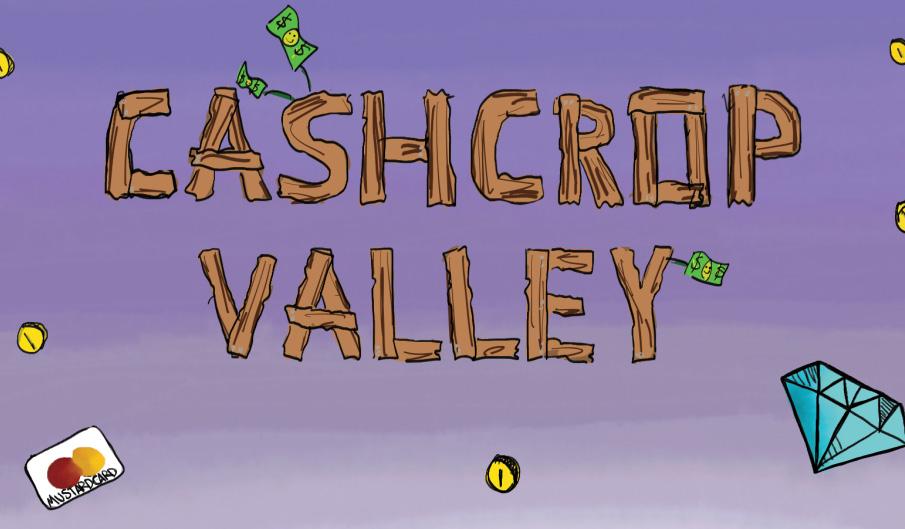

“Money,
carrots, summer squash, broccoli, and powdermelon – that you can find by hoeing up the ground.
Robin can now offer you four new additions to your home: a dining room, an attic, a larger corner room, and a little cubby room.
There are tons of new items too. A big one is, well, the big chest. It has double the storage space as a regular chest. There’s also a dehydrator for your fruits
a
and mushrooms, so you can dehydrate things for more money no matter what cave type you choose from Demetrius.
There’s a bait maker for fish-specific bait to help you catch that annoying sturgeon by Robin’s house. Speaking of fish, there’s a fish smoker that doubles the value of your fish. And speaking of double, the new heavy furnace can process more than one bar at a time.
Time with friends, painting, frogs, and SEPP make for a great
On Thursday, March 28, if you were at the University of Regina near the University of Regina Students’ Union’s Multi-Purpose Room from 5-7 p.m., you may have noticed a small group of people painting. This was the Saskatchewan Equity and Parity Project (SEPP) Paint Night, where attendees were instructed on how to paint a frog on a tree branch.
This paint night was $20 for students and minors, and $25 for the public. These ticket prices covered the price of paint, paint brushes, a canvas, and some refreshments for each attendee for the night.
Although there was an instructor present, they did not claim to be in complete control over how each attending artist painted their frog. As such, when one of the attendees painted a beautiful rendition of… something distinctly un-froglike, everyone in attendance took great enjoyment in being able to see it.
For those of us who did make a frog, each of our frogs was different and beautiful in their own ways. For my part, my frog – whom I named Frogbert – was pink instead of green, and had confused eyebrows. There were a few other frogs that stood out to me for their creativity or for the jokes that were made about them.
One of these frogs was sort of heart-shaped, though that was a happy accident. There was another attendee who was wearing a Star Wars shirt who painted a sith frog with a rendition of the
Death Star exploding in the background. That was a truly inspired addition to the group’s collection of frogs.
We were jokingly told at the beginning of the night that, in order to pass, we had to name our frogs, and there were so many frog-themed names at the end of the class; it was glorious. Puns
you have the chance. They also are doing incredible and important work that is supported by attendance at events like this.
For those who don’t know, according to their Instagram account (@sepp.yqr), SEPP is a project which provides “programming in promotion of gender equity and parity within positions
following them specifically is probably your best bet.
This event was not done in association with the Paint Nite brand, but there are plenty of events from them in the near future, if you would rather attend those. Places to look for paint nights near you include eventbrite.ca or simply searching


I wonder what Frogbert is looking at that’s got him so confused…
are, of course, loved by everyone, so that was not too surprising. All in all, SEPP’s paint night was a greatly enjoyable and relaxing event. Though there aren’t currently any released plans for another paint night from SEPP, I highly recommend attending if
of leadership. We encourage community building and have a focus on feminist principles in the labour market!”
On their account, they also have introductions for each of their members. For updates on any future events they may hold,
on your favourite search engine “paint night near me.”
Old trees can now grow moss that you can pick up, and you can find jelly when you fish. There’s even a brand new fish, the Goby, and a brand new pet, a turtle. I know that there’s a lot of new stuff, but the best way to explore it is by playing the game yourself, or with friends, because 1.6 allows you to play with up to eight friends instead of the original four.
Happy farming!
Now, what you’re going to do is head to YouTube (or a YouTube alternative if you don’t feel like dealing with all those ads) and search up “Bob Ross.” This may seem like a, “Well, duh,” sort of situation to some, but sometimes people don’t know what you know, so it is still a relevant recommendation.
As I have done this with my friends previously, I can attest to its entertainment value. My friends were really “by the book,” but I was having some trouble with mixing the right colours and accidentally painting over things on different layers, so mine ended up looking much different than theirs.
This only added to its sentimental value though, so I do recommend experimenting with colours during a paint night if you want to make your painting more one-of-a-kind!
One note I would like to make though is that if you’re trying to add something, say an animal, from memory, maybe look up a photo to be sure you aren’t forgetting an important piece of their body. Adding a bunny in the corner that is lacking ears makes for a very confusing situation for both the artist and any viewers
mikayla tallon a&c editor
If you would rather not attend an event, but still want to enjoy some time painting by yourself or with friends, all you really need is paint, paint brushes, a canvas, an internet connection, and something to watch a video on.
If you need a new café to check out in Regina, read on!
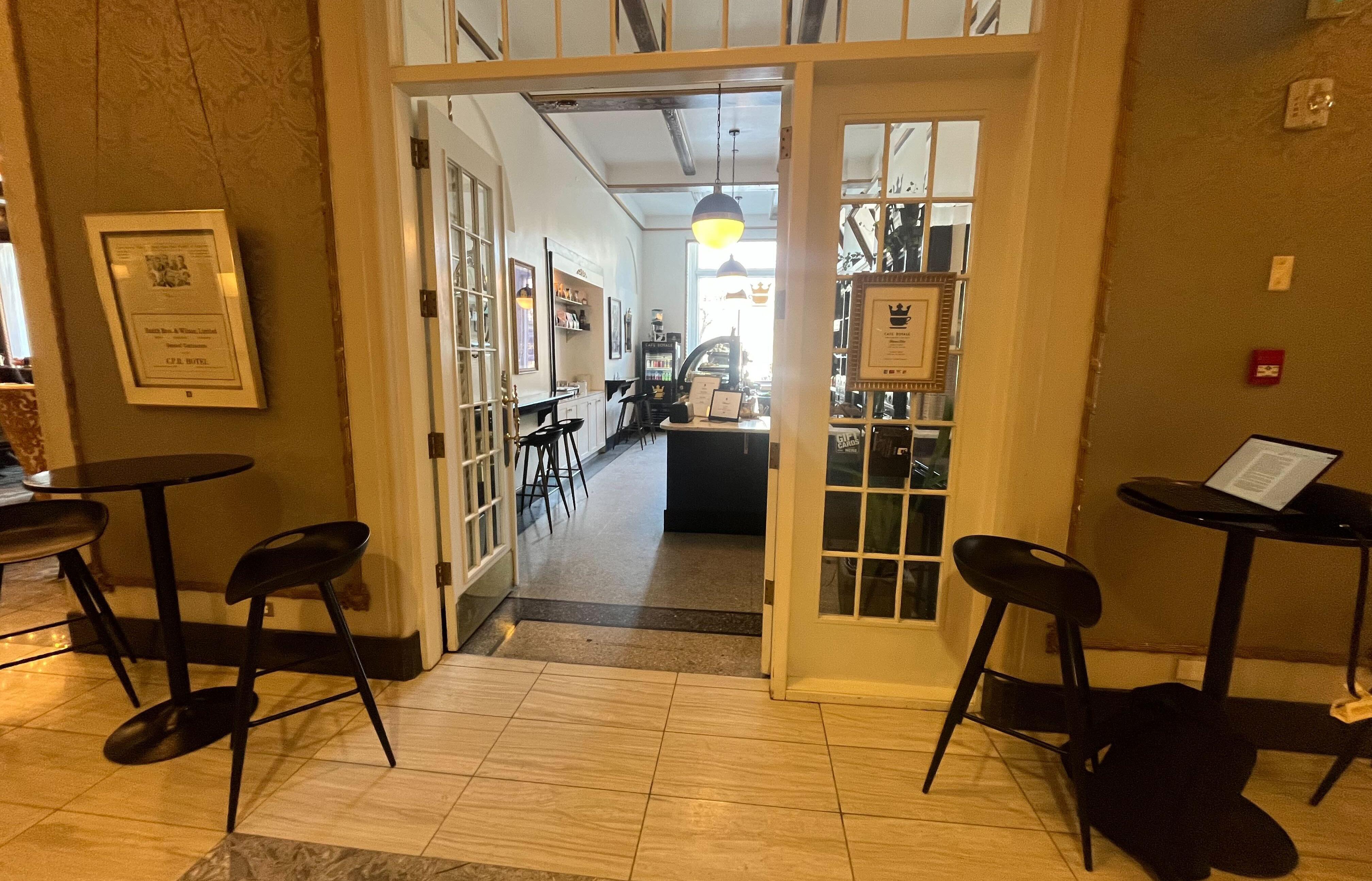

In the heart of downtown Regina, placed inside the Hotel Saskatchewan, is a small but beautiful café known as Cafe Royale. Cafe Royale is a locally-owned café that works to strive for a special coffee experience and a warm sense of hospitality.
Cafe Royale can be found on the main floor by entering the lobby and walking straight in
They’ve got the basics that everyone can enjoy like mochas, americanos, lattes, and freshly brewed coffee. Then they also have great smoothie and tea options, if you don’t feel like coffee!
The treats they have are just as good as well. When I visited the café, they had options like stuffed cookies, protein balls, baked banana bread, macarons, and more!
month a subscription buyer would enjoy different varieties. I think this is a unique and very cool idea to have, especially for coffee lovers who enjoy trying different kinds of beans, strengths, and tastes!
When I went to the café, I enjoyed an iced vanilla matcha latte with almond milk. Quite honestly, it was the best matcha I have had
coffee, and head out to their next outing as quickly as they feel like.
When I visited, I enjoyed sitting in the café and listening to music for a while, but then I spent some time in the lobby. The lobby is a beautiful location and has a great number of details. With gorgeous chandeliers, calming and relaxing music, gorgeous artwork, a grand piano, and more,
gina. The heart of downtown is where you can visit Victoria Park, Cornwall Centre, and other local shops located in the nearby Cathedral area of Regina.
If you were also to visit Cafe Royale, you could choose to go and enjoy your drink in a beautiful park, since Victoria Park is just across the street. This could be a great summer, spring, fall, or
“What a wonderfully joyful option to have.”
Victoria Baht
from the front entrance doors and turning right.
On the Cafe Royale website – caferoyaleregina.ca – under About Us, it states that the café was founded by Tyler Koda and Tara Barlett in 2018. They work together to provide a business to the small community of Regina Downtown. The café is open Monday to Friday from 7 a.m. to 3 p.m. with weekend hours from 8 a.m. to 2 p.m., and is closed on statutory holidays.
When you walk into the café, you are welcomed by a beautiful and shiny palette. You are surrounded by details of gold, pictures hung up on the wall, books, and more. You can sit at tables inside the café or take your beverage to go. Overall, the café is a very welcoming and relaxing environment.
Inside the café, they have some great beverage options.
I was happy to see macarons on the menu; it’s fitting to see such a fancy and regal dessert in a place with a name like Cafe Royal. You could also stop in and grab a snack or some breakfast as well. As I mentioned, they had some great smoothie options, as well as house-made sandwiches such as avocado toast, west coast bagel, and more. The west coast bagel sounds like one to try, with its ingredients being salmon, avocado, and cream cheese on a 12-grain toasted bagel.
Additionally, one thing I noticed on the Cafe Royale website under the Shop section was that they have two unique options; they have a three-month filter subscription and a three-month espresso subscription.
These subscriptions mean the buyer can enjoy having three months of espresso or filters being delivered to their door. Each
in a while. It was smooth and the vanilla added a little something extra.
A nice additional touch that I found Cafe Royale had was business cards to their website which included a QR code. When scanning the QR code you were brought right to the menu online where you could see all the drinks, smoothies, and all of the other menu options! This gave guests the option to pre-order online and pay, as well as to keep the business card for any future visits they may want to make.
I think a café is a great touch to have, especially in a hotel setting. When people are on vacation, they’re often looking for convenience, and how much more convenient can a cafe be than being right in the hotel? Guests of the hotel can even take a business card up to their rooms so they can visit the website, order their
there was much to look at and feel welcomed by. The lobby also had a restaurant, barber shop, and a spa for guests to enjoy.
Hotel Saskatchewan is well known for being the most luxurious hotel in the province and has been located on 2125 Victoria Avenue since 1926, opening in 1927. The history of Hotel Saskatchewan is quite interesting.
In fact, according to Canada’s Historic Places website under Hotel Saskatchewan, it states that this hotel plays a key role in the history of Saskatchewan. Having hosted many special guests and events – anywhere from political events to economic and cultural – the hotel’s importance is clear. The hotel even hosted Queen Elizabeth II.
Not only does Hotel Saskatchewan have a history of serving importance to the province, but it is also in a prime spot in Re-
even winter outing by going and grabbing a treat and then walking around in the sunlight and warmth of downtown Regina. What a wonderfully joyful option to have.
I found Cafe Royale such a perfect, cute, and admirable little café in downtown Regina. To me, it adds a place that is welcoming and perfect to have in the heart of downtown.
The Regina downtown area is always a busy place with lots of business and people coming and going, being hard at work. Finding a café that is welcoming, convenient, and easy to access is exactly what the downtown community of Regina needs.






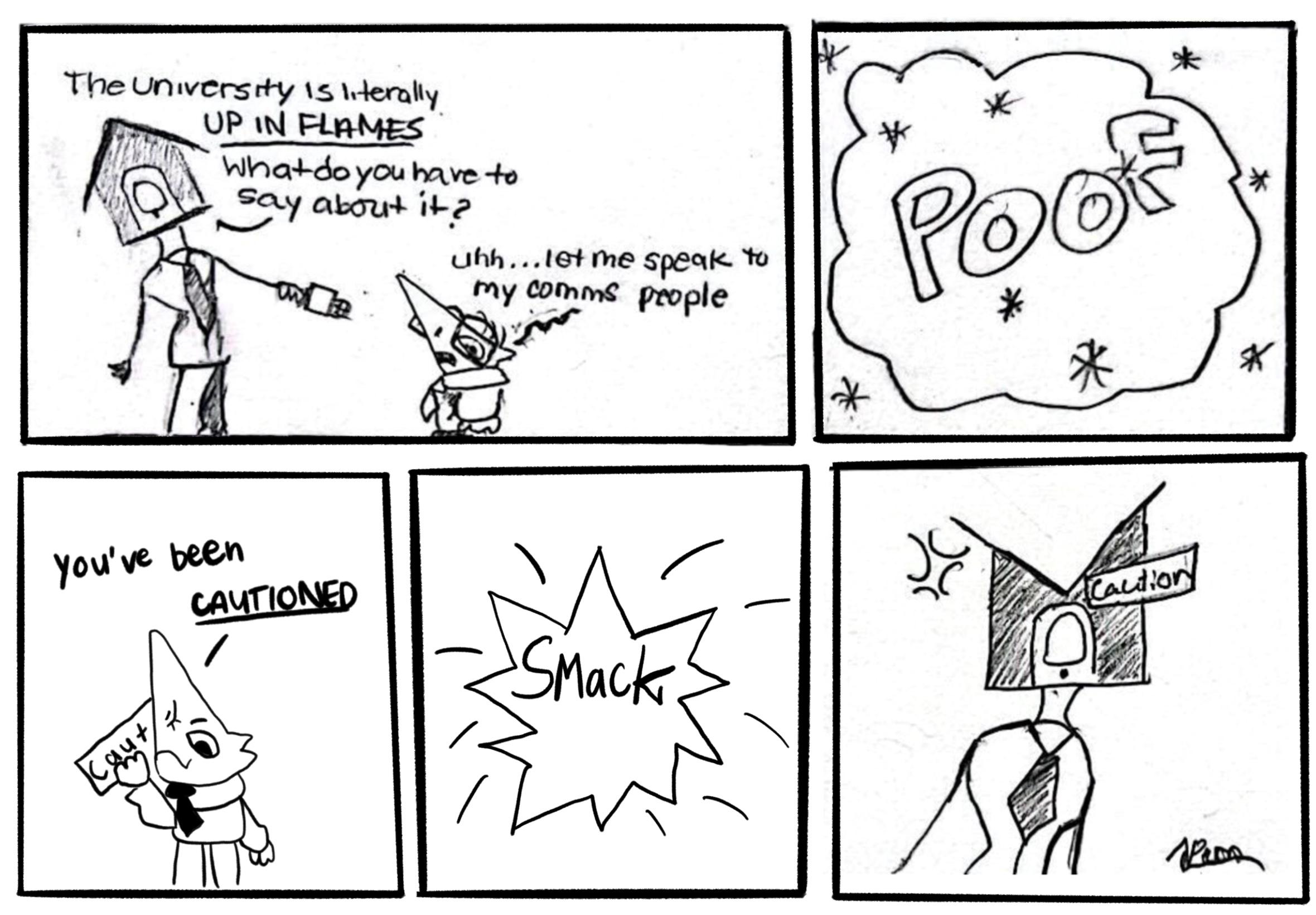
Trying something new can be renewing
victoria baht staff writer
A few weeks ago, I had the opportunity to attend my first sweat lodge ceremony with the Nēwo-Yōtina Friendship Centre as part of my practicum placement. The ceremony was a renewing and incredible experience.
According to an article written by Rene R. Gadacz in The Canadian Encyclopedia on Feb 7, 2006, “Sweat lodges are heated, dome-shaped structures used by Indigenous people during certain purification rites to promote healthy living.” Historically, these lodges were small, domed structures draped with buffalo or deer hides, but sweat lodges made today are usually made of wood and covered with tarps and blankets.
The heat that is created inside the lodge promotes sweating throughout the ceremony to cleanse your body of toxins and imbalances that may be taking place.
According to the Indigenous Saskatchewan Encyclopedia, this purifying ceremony can be performed alone or in preparation for other ceremonies, like a Sun Dance. However, a sweat lodge ceremony can look drastically different depending on the culture and the specific person who hosts it.
This article is going to talk about my experiences with the sweat lodge ceremony that I attended.
The sweat lodge ceremony I attended was very spiritual and beautiful. It started with everyone gathering and getting settled in together. Women were strongly encouraged to wear a ribbon skirt and a shirt, and men were encouraged to wear shorts with no top when attending the ceremony. Once everyone was dressed and prepared, the ceremony started.
First, everyone began with a smudge. “A Definition of Smudging,” an article from the Indigenous Corporate Training Inc., posted on Feb 16, 2017, states, “is traditionally a ceremony for purifying or cleansing the soul of negative thoughts of a person or place.”
As the shell holding the plants and releasing the smoke is shared throughout the room, each person holds the shell and waves the smoke over their body and mind to cleanse of negative thoughts.
According to The Centre for Indigenous Support and Community Engagement, medicinal plants such as sage, sweetgrass, cedar, and/or tobacco are burned in an abalone shell, with the smoke “rising up to the Creator.”
darkness allowed me to focus on what was happening and encouraged my body and mind to settle.
As the ceremony begins, the lodge started to heat up as the rocks in the centre pit heat and let off steam into the lodge. The ceremony leader can put water onto the stones to release more heat through steam. As you are sitting in the lodge, you listen to the leader talk, sing, and share their messages and teachings. During this time, participants get to listen and
It allowed me to listen, take deep breaths, and calm my breathing, mind, and soul. As I sat in the lodge and listened to the leader talk, I felt the messages personally. It was a beautiful feeling to gather with everyone and spend time together.
There are four parts to the ceremony, each lasting a few minutes. Once each part is done, you can choose to leave the lodge, grab some fresh air and water, cool down, and be welcomed
| april 4, 2024
we had traditional bannock with soup. The feast concluded the ceremony.
After the sweat lodge ceremony, my body and mind felt amazing. I felt so refreshed, cleansed, and clear-minded of all things negative. It truly is hard to explain, but it was an amazing feeling. If you want to join and partake in a sweat one day, it is highly encouraged and an amazing experience like no other.
If you would like to attend

Next, we all gathered in the sweat lodge. The lodge itself was a dome-shaped structure with a pit in the centre. The pit is where the rocks are placed and where the heat is generated. As you gather around, women sit on one side, and men sit on the other. The door is then closed, and the ceremony begins.
It is pure darkness inside the lodge, which some people may find unsettling. However, the
enjoy the ceremony.
While sitting in the lodge, I sat with my legs bent and crossed with a towel wrapped over my head. Participants are encouraged to bring a towel to wipe the sweat off and to help them breathe. I focused on my breathing when I noticed the sweat lodge getting warm. This was very calming, as it allowed me to take a moment to be meditative and focus on one thing at a time.
back in for the next part.
Once all four parts of the sweat lodge were completed, we gathered for a feast. At the feast, everyone was encouraged to take a bit of everything and enjoy the food that was made. To start, we had salmon and corn mixed together and berries. We dished by handing a bowl from person to person, taking a spoonful before passing it along. This went on until all the food was gone. Then,
“It allowed me to listen, take deep breaths, and calm my breathing, mind, and soul. As I sat in the lodge and listened to the leader talk, I felt the messages personally.”
Victoria Baht
a sweat lodge ceremony, I highly recommend it. However, make sure to wear light, natural, and breathable clothes made of materials like cotton. You should also bring water for after the ceremony. Sweating will dehydrate you, so you will need to drink some water before and afterward.
In Regina, The Place of Hope/Awasiw and the Nēwo-Yōtina Friendship Centre host sweat lodge ceremonies that are open to the community. Awasiw/The Place of Hope provides outreach services like ceremonies, access to knowledge, resources and support, and the All Nations Hope Network operates it.
Sweat lodge ceremonies are posted on Nēwo-Yōtina Friendship Centre’s Facebook page. When attending a sweat lodge ceremony, you will be asked to bring your own tobacco, towel, ribbon skirt, and a change of clothes.
Teach a child to play music, and they are set for a lifetime
pall agarwal s&h writer
Music has an impact on everyone, regardless of age or developmental stage. Playing an instrument has its own benefits for adults and children. According to an article in The Economist, “Evidence suggests that the rewards go far beyond the elation of performing well in front of others – those who play instruments have often been found to perform better on cognitive tests too.”
Learning to play instruments involves a journey of melodies, weaving stories, and rhythm to paint emotions. From sharpening cognitive skills to nurturing emotional well-being, engaging with music transcends age, offering a symphony of rewards for individuals at every stage of life.
The benefits know no bounds, but most importantly, learning to play an instrument has a positive action on cognitive skills. In an article by Ewa Miendlarzewska and Wiebke Trost published in the National Centre for Biotechnology Information, “Neuroimaging studies have shown that musically induced emotions involve very similar brain regions that are also implicated in non-musical basic emotions, such as the reward system, insula, and orbitofrontal
cortex, amygdala and hippocampus.” These areas are involved in motivation, memory, and decision-making.
The article explains that “music training correlated with plastic changes in auditory, motor, and sensorimotor integration areas. However, the current state of the literature does not lend itself to the conclusion that the observed changes are caused by music training alone (Merrett et al., 2013).” Plasticity refers to the brain’s ability to adapt to and learn to work with new stimuli, which is a key part of brain development. Music training may boost plasticity.
If children are more cognitively stimulated, they may perform better academically, in following instructions, and creatively. Playing an instrument or even surrounding oneself with music translates into improved memory, attention span, and problem-solving skills, which are essential for academic success and lifelong learning.
While learning an instrument, children develop motor skills which involves precise coordination of the hands, fingers, and sometimes even the feet for instruments like drums. When learning to play, children are not only developing their bodily coordination but also improving their
Increasing risk of
attention to detail and multitasking by playing the instrument and also reading notes.
Mastering different music pieces instills a strong belief in their abilities and capacity to overcome challenges and obstacles to achieve their goals. The supportive community of fellow musicians and mentors is also instrumental in this journey through their encouragement and validation, which may reinforce a positive self-image.
Engaging with learning to play an instrument can provide children a sanctuary of calm and relaxation. In addition to the developmental benefits that playing an instrument brings, it brings joy.
Playing an instrument releases endorphins – chemicals your body releases during activities like exercise, relaxation, and eating. Endorphins also reduce cortisol levels, commonly referred to as the stress hormone, which when reduced promote a sense of peace and well-being. Incorporating music into their routine may help children cope with negative emotions.
Music indeed has the power to enrich and elevate every aspect of our lives. From enhancing cognitive skills and fostering emotional expression to promoting social connection and instilling confidence, the impact of music goes
Do your part and you too can stay safe from measles
In an email from Student Affairs on March 28, the Saskatchewan Health Authority (SHA) warned of an increasing risk of measles.
Measles is a highly contagious infection spread by air. Someone with measles can spread it by coughing, sneezing, or sharing food and drinks, and you can contract measles by breathing infected air or eating and drinking infected foods.
This is not to scare anyone, however. Contracting measles is highly preventable through vaccination, masking, and the cooperation of those who think they may have been exposed to measles or are showing symptoms.
Mayo Clinic describes measles as a childhood infection that “spreads easily and can be serious or even fatal for small children. […] Most recent measles cases in the U.S. originated outside the country and occurred in people who were unvaccinated or who didn’t know whether or not they had been vaccinated.”
According to the SHA, measles is a virus that causes a rash all over the body. Initial symptoms include a high fever, running nose, sneezing, sore throat, coughing, swelling of the lymph nodes in your neck, tiredness, diarrhea, and red, sore eyes. After these symptoms go down, tiny white spots will appear inside the mouth, followed by a full-body rash.
Symptoms appear around
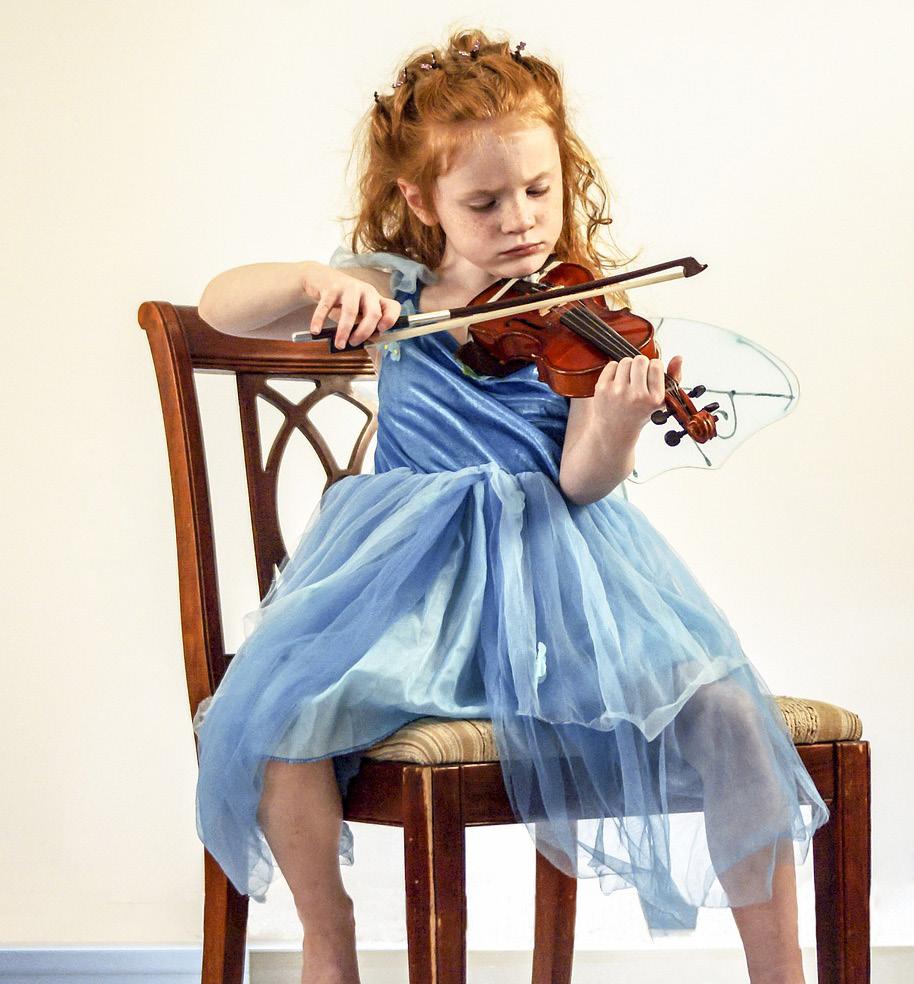

beyond our understanding. For children, the journey of mastering an instrument lays a foundation of lifelong learning, creativity, and personal growth that is well observed in the later stages of one’s life. Children are not only empowered with invaluable skills and qualities but also cultivated with the ability to shape their minds for the better-


I’m going to be the next German man getting 217 COVID shots, but with the measles vaccine…
Illustration: HtcHnm via Pixabay, manipulated by lee lim
one to two weeks, or 7-14 days, after exposure. Adults tend to experience symptoms at a worse severity than children who get it.
So, staying up to date on vaccinations is essential.
The email sent out by Student Affairs said, “The virus remains active and contagious in the air for up to two hours. The best way to protect yourself from measles is through vaccination. Two doses of a measles-containing vaccine is 97 per cent effective at preventing the disease. If not
up to date on their vaccinations, anyone can spread and catch measles.”
The email goes on to write that eligibility for publicly-funded measles vaccinations depends on a person’s date of birth. Babies are eligible for two doses of a measles vaccine like the Measles-Mumps-Rubella-Varicella (MMRV) vaccine, with a dose given at 12 months and then 18 months.
Adults born in 1970 and onwards are eligible for two vaccina-
tions. If you were born between 1957 and 1969 and travelling outside of Canada, you are eligible for one dose. For anyone born before 1957, no vaccination is required. Students of healthcare professions are eligible for two doses no matter their birth year.
The email ends by reminding everyone that Saskatchewan residents can access their vaccination records on the MySaskHealthRecord website. Anyone 14 or over can register for an account. To register, you will need your health
ment of society. According to a blog by Lia Peralta, “At the core of our everyday experience with music, we use it to relax, express ourselves, come to terms with our emotions, and generally improve our well-being. It has evolved into a tool for healing and self-expression, often dictating how we, individuals, take steps to impact society.”
card, some form of picture ID on hand, and an email address. Prevention is good, but what if you contract measles or come into contact with someone who later finds out they have measles? The SHA suggests calling a healthcare provider to describe your symptoms before you physically go to healthcare facilities. This will decrease potential exposure to others if you are infected, and allow you to remain home and comfortable while you make the call.
The at-home treatment for measles is similar to that for the common cold: medicine to lower the fever, rest, and drinking lots of fluids. Additionally, the SHA advises staying away from other people as much as possible and staying out of public spaces for at least four days after the rash first appears.
This includes work, grocery shopping, friend activities, and anything that requires being close to anyone else. Essentially, self-isolate if you suspect you have measles or have confirmation that you do, just like you should with any other contagious illness. Stay safe, stay vaccinated, and stay healthy everyone! kimberley kaufman s&h editor
A SW degree is good, but an ISW degree may be even more beneficial
pall agarwal s&h writer
It is not a regular week in March without recognizing Saskatchewan’s Social Work Week. Involving a time of reflection and celebration within the Indigenous community, the Indigenous Social Work (ISW) program at First Nations University of Canada (FNUniv) in Regina, Prince Albert, and Saskatoon is taking center stage, hosting a week of events to honour the cultural contributions of Indigenous social workers.
Last year, the Government of Saskatchewan declared March 20-25 as Social Work Week in Saskatchewan. Their theme was Social Work is Essential. This year, March 18-23 was Social Work Week, with the theme Seven Points of Unity; Many Possibilities. To better understand the program and the significance of an Indigenized social work program, it’s essential to delve into the history of social work itself.
In a March 18, 2024, news release, the Saskatchewan government wrote, “Social workers assist individuals and families in need to navigate through difficulties in their lives. They provide supports and services to help overcome significant challenges, including substance use, intimate partner violence, mental health crises and intergenerational trauma. Across the province, social workers can be found working in public or private practice, in community-based organizations, and across the health and mental health, education, justice, disability, and child and family sectors. They may also be engaged in research, policy, planning or administration.”
The FNUniv campus in Regina currently has 3 programs for ISW: Certificate of Indigenous Social Work, Bachelor of Indigenous Social Work, and Master of Indigenous Social Work. These programs are intended to enhance the cultural competency of social workers of Indigenous communities and groups.
The idea of this program is to provide students with the perspective to deliver work from an Indigenist, anti-oppressive perspective, consistently self-reflecting and developing as social work practitioners.
According to Volume 3, Issue 2 of the Journal of Indigenous Social Development Program in Manitoba, “to practice from an Indigenist perspective requires an understanding of Indigenism. An Indigenist practitioner incorporates traditional Indigenous values, beliefs, ethics, practices, ceremonies, and social structures.” The program gave students a lot of flexibility and provided instructors the accessibility to increase the reach of their program.
Even newcomers are surprised to learn that Canada offers Indigenous studies in their social work courses. In an inter-
view with CBC, Fiyan Lam said, “In Canada their social work studies always includes the topic of Indigenous people, and in some job advertisements they’re also mentioning that. So, I think this is quite an important part.” Lam was trained in social work in Hong Kong and researched job requirements related to that field in Canada.
the Indigenous Advisory Circle defines Indigenization at the University of Regina as, “The transformation of the existing academy by including Indigenous knowledges, voices, critiques, scholars, students and materials as well as the establishment of physical and epistemic spaces
they hired were equipped to work with the communities.
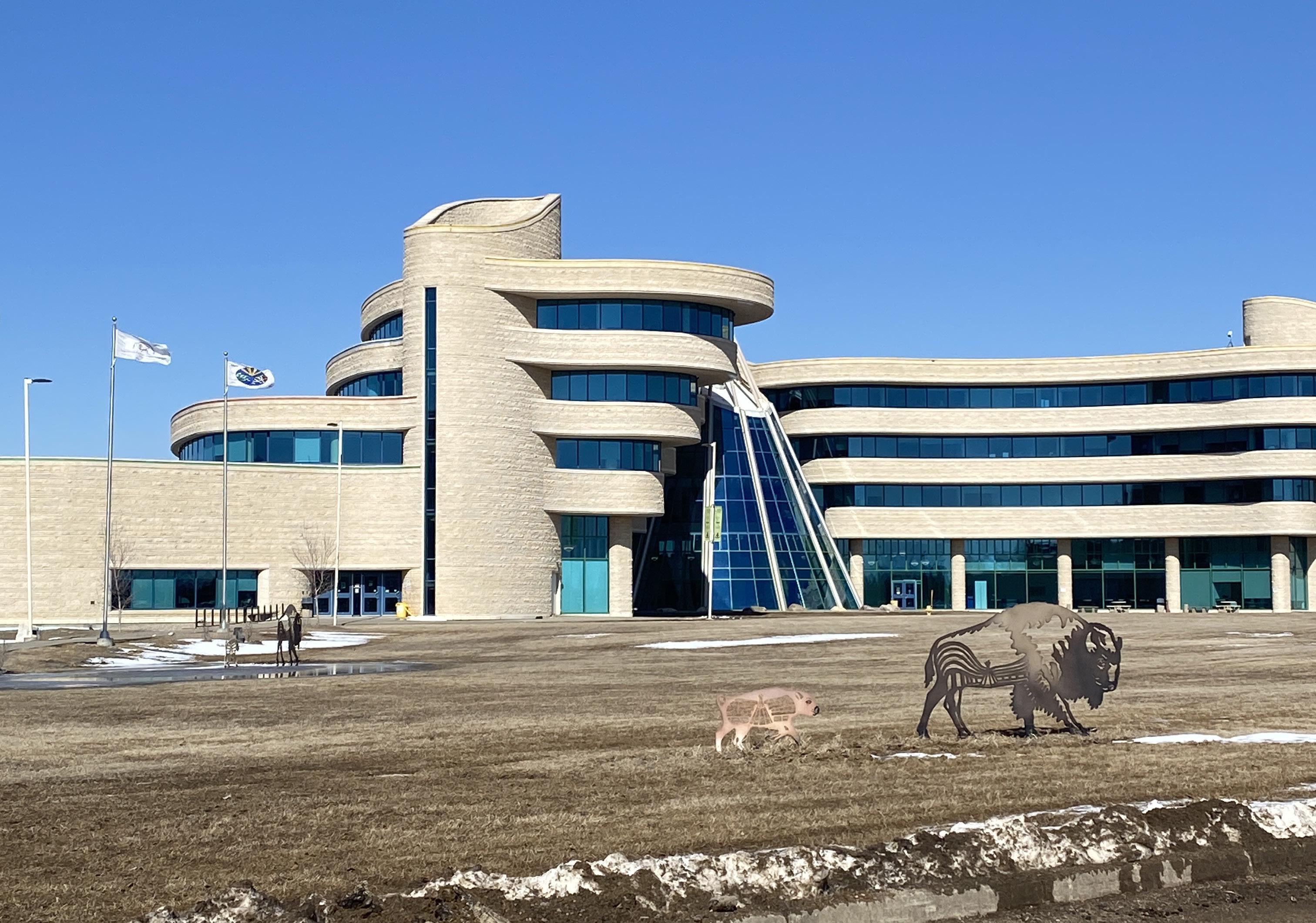
This is important when noting the global relevancy and significance that Indigenous knowledge holds in social work. It is imperative to notice how inclusive the social work programs are in Canada with the inclusion of Indigenous topics so that people know about the history but at the same time strengthen the values that various First Nations hold.
According to Dr. Shauneen
Pete, Executive Lead of the UR Strategic Plan, All Our Relations,
“ It is not limited to Indigenous people, but encompasses all students and faculty, for the benefit of our academic integrity and our social viability.”

Dr. Shauneen Pete
that facilitate the ethical stewardship of a plurality of Indigenous knowledges and practices so thoroughly as to constitute an essential element of the university. It is not limited to Indigenous people, but encompasses all students and faculty, for the benefit of our academic integrity and our social viability.”
When Indigenous topics and knowledge is included in the education provided at the university level to all students, it is a key indicator of success. Programs like the ISW program is one of the first steps to increase academic programming partnerships and collaborations with FNUniv. This will address the definition of Indigenization further and add toward the goal decided. Even adding spaces for students to learn, interact, and engage on campus and in community is imperative to remedy the knowledge gap.
According to Katie Hyslop in The Tyee, “’Someone who graduates with an Indigenous specialization will learn that cultural knowledge, they will learn about identity, colonialism. But more importantly they will learn, or relearn, ceremonial teachings or cultural practices,’ said Jacquie Green, alumni and director of the UVic school of social work.”
Green was working on her social work master’s degree and went around British Columbia to learn more about the Indigenous communities, asking if the people
The answer shocked her as most of them said no, because they graduated with a Bachelor of Social Work (BSW). This is where programs like ISW bridge that gap and give students the tools, capabilities, learning, education, and skill to work with the communities better and more effectively.
A BSW degree includes required courses in Indigenous studies, but an ISW degree seems to enhance cultural understanding and competency in practice significantly. Social workers need to understand the history and cultural factors in order to properly support Indigenous populations, making an ISW degree and required Indigenous courses in a traditional BSW degree very important.
It is evident that the strides made by social work are ongoing, but there is still a long way to go and a lot of work to be done. By amplifying Indigenous voices and fostering meaningful dialogue, Saskatchewan can continue advancing the social health and well-being of Indigenous peoples.
Saskatchewan’s Social Work Week remains a poignant reminder of the enduring impact and ongoing evolution of the social work profession and its results, particularly within the Indigenous community. A path still needs to be laid out to create a more inclusive and equitable society where every individual has the opportunity to thrive and live with dignity and respect, as well as uphold every profession with integrity.
Hurting teachers eventually hurts us all
alissa sadler contributor
We have all had teachers all our lives. We may not have always had good personal experiences with them, but one thing remains certain: they are undoubtedly a necessary part of raising the next generation, and they are crucial to society. Their value has become abundantly clear during this year’s job actions from the Saskatchewan Teacher’s Federation (STF), which represents 13,500 Saskatchewan teachers.
While some think this is sudden, protests like this do not come out of nowhere. They often stem from complicated past interactions and building tensions, and this scenario is no exception. The provincial government has long shown little care for schools, which has resulted in poor working
provincial committee to investigate classroom complexity.
Classroom size and complexity have also become primary negotiation points for the STF because of a well-documented increase in student enrollments and complex classrooms with fewer supports. However, the provincial government is refusing to bargain this, claiming that it is a job for local school boards. This is questionable, as other federations and unions across Canada, such as in Ontario and Quebec, regularly discuss class size and composition with their respective governments. The Supreme Court even ruled that the government of British Columbia infringed on teachers’ bargaining rights by refusing to negotiate class sizes. Why do the same rules not apply to our government?
The government has offered a memorandum of understanding to address the
since 2015. Out of all provinces, we are in second-last place in per-student operational funding, which has decreased by 14.2 per cent between 2013 and 2020. The 2022-23 school year saw the largest student enrolment growth in 20 years with almost 4,000 more students in classrooms, but there were 300 fewer teachers in 2022 than in 2021.
Teachers are doing more than they are paid for. They supervise children at lunch and in extracurriculars for a fraction of their regular pay. Just thinking of keeping 30-40 eating (and often screaming) children under control by myself gives me a headache, and that’s not even considering the less-than-ideal compensation for it. They are also forced to take on more specialized roles they are not trained for due to simultaneous increases in students who need intensive support and declines in En-
and money into the staff and resources they need, the government is sending a message that they do not care about the success and future of a large part of our population. It is not surprising that teachers are protesting, and they should not be blamed. The fault lies in a government that has created these issues by neglecting education, demonstrated by a decade of underfunding. To fix this, they need to agree to binding arbitration and bargain on class size and composition. This is the only way to substantially address problems with Saskatchewan classrooms today, ensure that change actually happens, and prove that they do care about today’s youth.
So, instead of getting angry at the teachers for extracurriculars like HOOPLA and the Optimist Band Festival being impacted, parents, students, and other members of the public should make their
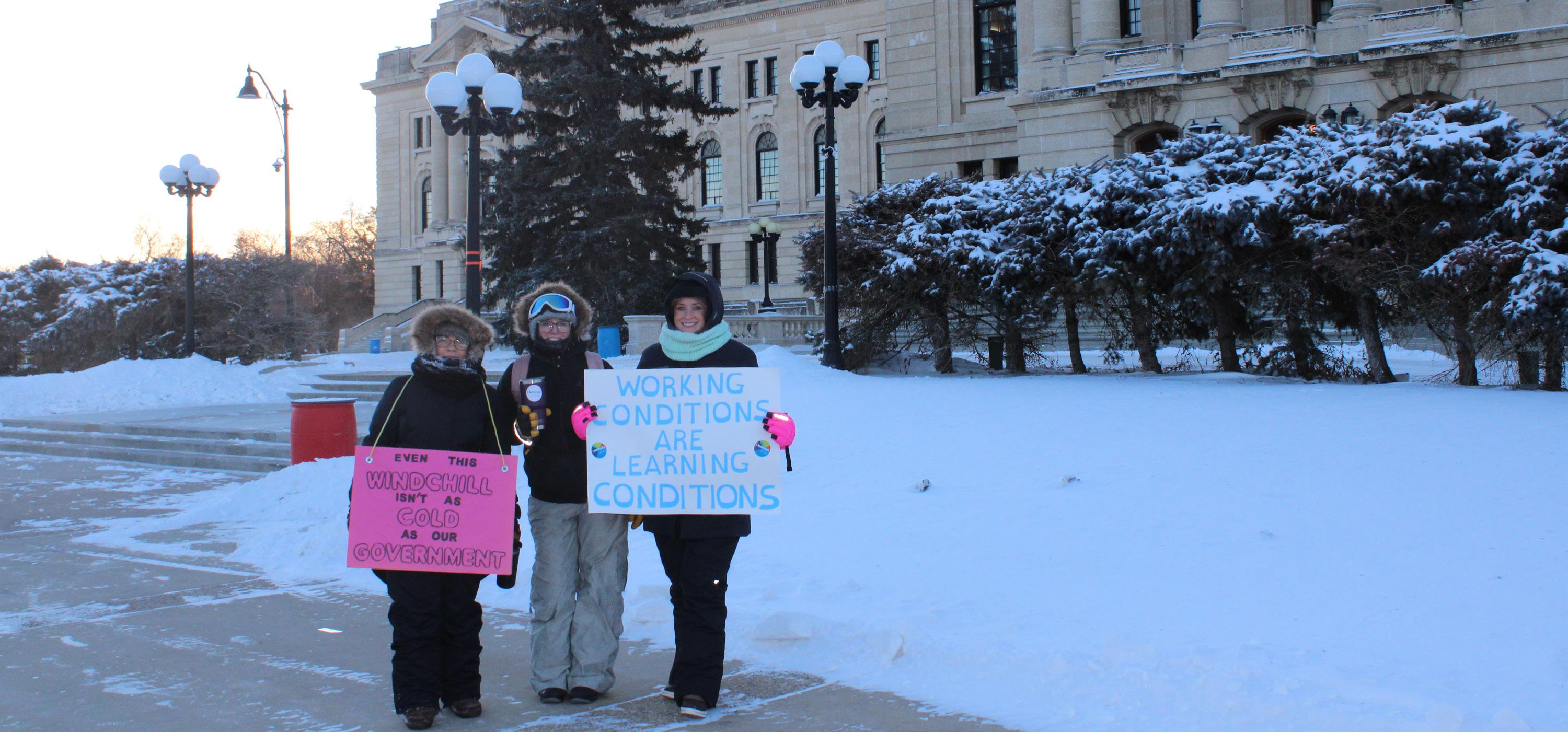

and learning conditions for teachers and students. It is now up to the government to listen to teachers, make long overdue changes to class size and complexity, and invest in Saskatchewan’s future before they lose more than just money and resources for classrooms. They may lose the bright futures of the youth of Saskatchewan.
Since the STF came to be in 1933, teachers have engaged in sanctions three times. Their main goal each time has been increased wages and more funding. This demand increased in urgency following a $54 million budget cut in 2017. Sanctions were set for 2020, but due to the COVID-19 pandemic, all that could be achieved was a quick contract that set salary increases at 6 per cent over four years and promised a
STF’s requests for more funding. While this could mean something, it could also (and likely does) mean nothing because there are no measures of accountability to ensure the funding actually happens. For all we know, this could just be lip service.
Understanding the state of Saskatchewan public schools helps to show why the STF is advocating so hard for change, and why we should be fighting alongside them. Many of the province’s teachers, parents, and school staff feel that learning conditions and staff morale have worsened over the last three years.
Teachers are burnt out and under-resourced, teaching in overpopulated classrooms. Saskatchewan has cut per-student public education funding by 10 per cent
glish as an Additional Language teachers, educational assistants, counsellors, and speech-language pathologists. Teachers are doing work that is significantly above their pay grade.
To put it bluntly, this is exploitation. It is so normalized that teachers not doing what they are not paid for is seen as job action. Teacher working conditions inevitably affect student learning conditions. Reading levels in early elementary schools have noticeably dropped since the pandemic. Students are also not able to get adequate oneon-one support due to over-populated and understaffed classrooms.
Students make up a higher proportion of the population in Saskatchewan than in any other province. By not investing time
concerns known to the government. This will show firsthand the negative effects of negligence on these students. We as the public must stand in solidarity with our teachers until we see real change in our education system. If we remain silent, we are complicit in the poor conditions happening in schools that should be an ideal space for teachers to teach and students to learn effectively.
The point is simple: the clock is ticking. Teachers, students, and parents alike are frustrated. The government needs to invest money and resources in our classrooms, for the sake of Saskatchewan’s future, before further damage is done to our youth.
“To put it bluntly, this is exploitation. It is so normalized that teachers not doing what they are not paid for is seen as job action.”
Alissa Sadler
zinnia jaswal contributor
In the grand tapestry of existence, the notion of a multiverse stands as a tantalizing hypothesis, offering a breathtaking glimpse into the boundless expanse of possibility. At its core, the multiverse theory posits that our universe is not alone, but is just one of an infinite number of parallel realities, each with its own unique set of physical laws, cosmic histories, and untold wonders.
Within this vast cosmic ensemble, every decision, every action, and every twist of fate spawns an alternate reality, branching off into an endless array of potentialities. From worlds where dinosaurs still roam to realms where humanity has reached the stars, the multiverse presents a captivating vision of reality as a kaleidoscope of infinite diversity and boundless imagination.
Several years ago Monza, Italy’s city council introduced an unusual law banning goldfish owners from keeping their aquatic pets in traditional spherical fishbowls. The rationale behind this measure stemmed from empathy: the council deemed it inhumane to confine a fish within the curved confines of such a bowl, arguing that it distorted the fish’s perception of reality. Beyond the immediate concern for the well-being of the goldfish, this incident sparked an intriguing philosophical question: how can we truly discern the authenticity of the reality we perceive?
The goldfish, confined to its spherical enclosure, experiences a reality distinct from ours. But can we confidently assert that its reality is any less genuine? It prompts us to consider whether we, too, might spend our lives observing the world through a lens that distorts our perception. This philosophical quandary resonates deeply, stirring contemplation about the nature of our own realities and the lenses through which we view the world.
In the realm of physics, this question goes beyond speculation; it forms the crux of contemporary discourse. Physicists and cosmologists find themselves confronting a parallel dilemma akin to that of the goldfish. For decades, the pursuit of an ultimate Theory of Everything has been underway – a comprehensive framework of fundamental laws elucidating every facet of reality. However, recent developments suggest that this endeavor may not yield a singular theory but rather a nexus of interconnected theories, each offering its unique perspective on reality, akin to viewing the universe through distinct lenses.
Recently delving into Albert Einstein’s life, I stumbled upon his intriguing venture into the realms of quantum theory, an endeavor left tragically unfinished. Einstein famously said, “I want to know how God created this world. I’m not interested in this or that phenomenon, in the spectrum of this or that element. I want to know His thoughts; the rest are just details.”
I found myself irresistibly drawn to this captivating notion. Einstein’s quest was not merely to unravel the mechanics of the universe but to delve into the very essence of creation – to comprehend the underlying patterns and principles that govern existence. For him, the intricacies of the natural world were like footprints leading to a higher understanding. In this simple yet profound statement, he encapsulated his belief that scientific exploration could reveal glimpses of the divine design of the world.
The film Back to the Future took us on a journey through the corridors of the multiverse, where the fabric of reality is woven from the threads of countless possibilities,
and where the line between science fiction and scientific inquiry blurs into a mesmerizing dance of cosmic revelation. Picture this: Marty McFly, a typical teenager with a knack for trouble, finds himself inadvertently thrust into the wild world of time travel when he steps into Doc Brown’s DeLorean. With a “Great Scott!” here and a lightning bolt there, they’re off on a rollercoaster ride through the years, dodging paradoxes as well as bullets in a shootout. But wait, there’s more!
Imagine if Marty’s escapades in the
“
traveling to a different point in history but to an entirely different universe altogether. In one reality, he lands in a neon-drenched ‘80s where hair metal reigns supreme and hoverboards are the preferred mode of transportation. In another, he finds himself in a world where dinosaurs never went extinct, and humans coexist with prehistoric beasts. There might even be a universe where everyone communicates exclusively in interpretive dance!
One fascinating aspect of the multiverse is the concept of “quantum entangle-
fundamental level of reality, subatomic particles aren’t tiny, indivisible points, but rather minuscule, vibrating strings. These strings produce various notes or vibrations, each corresponding to a different type of particle in the universe. The symphony of these vibrating strings generates the diverse array of particles we observe, while their harmonies dictate the fundamental laws of physics governing our universe. In essence, the universe itself can be envisioned as a grand symphony of strings, each vibrating in its unique pattern to cre-
The distinction between past, present and future is only a stubbornly persistent illusion.”

Albert Einstein


past not only altered history but also inadvertently influenced the very fabric of reality itself. Suddenly, we’re not just talking about alternate timelines; we’re delving into a multiverse of Marty mayhem! One where Biff Tannen rules with an iron fist, another where Doc’s inventions have shaped a utopian future, and perhaps, just perhaps, one where Marty accidentally becomes his own grandfather.
What if our universe is just one of countless others, each with its own set of rules, its own version of history, and its own quirky quirks? Maybe there’s a universe where gravity works in reverse, or where time flows sideways like a meandering river. Who knows?
Imagine if each time Marty punched in a date on the time circuits, he wasn’t just
ment” between parallel universes. In some interpretations, particles in one universe can become entangled with their counterparts in another universe. This means that actions taken in one universe could instantaneously affect the state of particles in a separate universe, regardless of the distance between them. Imagine Marty inadvertently altering history in one universe, leading to a chain reaction of events that ripple across the multiverse. These changes could potentially be detected through quantum entanglement, offering a tantalizing glimpse into the interconnectedness of alternate realities.
Within physics, the concept of a multiverse is intricately linked to a cutting-edge field known as string theory. In its essence, string theory proposes that at the most
ate the intricate tapestry of reality. According to string theory, this symphony extends far beyond our own universe, suggesting the existence of countless parallel universes, each with its own composition of vibrating strings and resulting physical laws.
Thus, our universe is just one stanza in the epic composition of the multiverse, with an infinite array of parallel realities waiting to be explored. As Einstein once wrote, “The distinction between past, present and future is only a stubbornly persistent illusion.” There might be copies of us living an entirely different life. The delicate dance of quantum probabilities underscores the bewildering array of potential outcomes that populate the boundless expanse of the multiverse.

